 Murphy is dying. Can’t stop it, might be able to slow it down a bit, as long as she’s comfortable. Not sure.
Murphy is dying. Can’t stop it, might be able to slow it down a bit, as long as she’s comfortable. Not sure.
All I’m really sure about is that she’s dying.
And that many people, including well-meaning friends, are idiots.
I’m sure most idiots don’t mean to be, well, idiots. But here’s a painful situation where all you can do is laugh at them, because what you really want to do is scream and cry and yell.
People say, “She doesn’t look like she’s dying.”
Well, what the hell does dying look like? Ask them that, nobody seems to know. They shrug, embarrassed, because truth is, in our ridiculous self-centered, youth-blinded culture, we have no idea what dying looks like. Because we don’t have to look at it. So we don’t.
Instead, we assume that death is old, debilitated, too feeble to walk, too sick to care, crippled and pathetic. Kept alive by a blind faith in technology and a refusal to let go until there’s very little left to let go of.
Death is something we lock away in nursing homes, or ignore until we can’t anymore.
People say, “She looks good. Are you sure she’s dying?”
Idiots. Yes, I’m completely sure. Don’t like it, but I’m sure.
And you know what? I’m glad she looks good. I’m glad she feels good. I’m glad the idiots are saying things like, “She doesn’t look like she’s dying.”
Because I realized that my life with my animals and theirs with me has defined a new way of living together as multi-species families. It’s defined a new way of looking at the human-animal bond.
It looks at animals as equals. At lives as valuable. At choice as real.
At death as part of the process, part of our lives together.
Ironically, it’s only at the end of a beloved animal’s life that I realize we are defining something more for multi-species families: we are defining what death looks like.
Death looks like Murphy. Vigorous. Happy. Tired.
Dying.
We don’t like it. But we’re living with it. Until it’s here upon us. And then we’ll say goodbye.
Not one second sooner.
(c) 2012 Robyn M Fritz
 The human-animal bond is a strange and wonderful thing. Living a multi-species family life is both inspiring and terrifying: every day you should be realizing that it’s one less day, not one more, but you don’t. You can’t.
The human-animal bond is a strange and wonderful thing. Living a multi-species family life is both inspiring and terrifying: every day you should be realizing that it’s one less day, not one more, but you don’t. You can’t.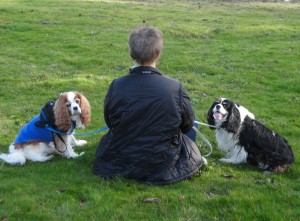 Every January people think about New Year’s resolutions. I never did get that, maybe because I think of life as a choice, and I’m glad I get them.
Every January people think about New Year’s resolutions. I never did get that, maybe because I think of life as a choice, and I’m glad I get them. 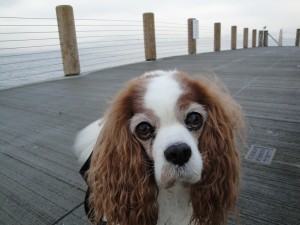 But we now know that Murphy’s journey is ending. She has a tumor on her spleen, and there are no easy choices. Remove her spleen and she may live, a few weeks or years, we don’t know. But if it’s a bruise or a tumor that is the spleen’s own way of dealing with a lifelong platelet disorder, maybe, just maybe, surgery is not the answer. And right now it isn’t, anyway, because this all started because she had a mild cough and UTI, and she has an infection to beat first.
But we now know that Murphy’s journey is ending. She has a tumor on her spleen, and there are no easy choices. Remove her spleen and she may live, a few weeks or years, we don’t know. But if it’s a bruise or a tumor that is the spleen’s own way of dealing with a lifelong platelet disorder, maybe, just maybe, surgery is not the answer. And right now it isn’t, anyway, because this all started because she had a mild cough and UTI, and she has an infection to beat first. 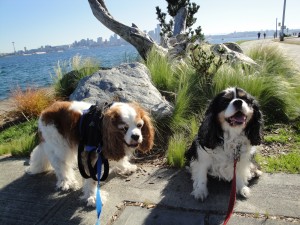 When you live the human-animal bond, you celebrate birthdays with your multi-species family.
When you live the human-animal bond, you celebrate birthdays with your multi-species family.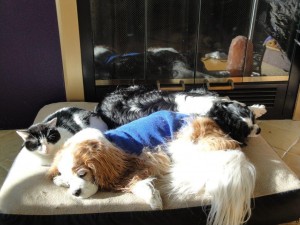 I awaken in the night and hear it. Silence. I wait for more. It comes. I smile.
I awaken in the night and hear it. Silence. I wait for more. It comes. I smile.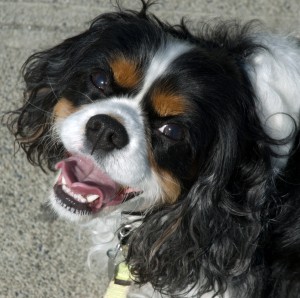 Living with anyone, especially yourself, can be irritating. You have grand illusions about being saintly, or at least perfect, but reality doesn’t seem to work like that.
Living with anyone, especially yourself, can be irritating. You have grand illusions about being saintly, or at least perfect, but reality doesn’t seem to work like that.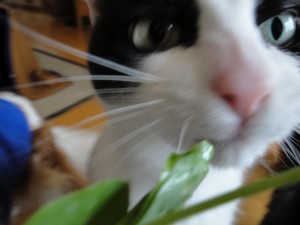 Cooking is a skill I apparently lost with menopause—and only miss when I’m hungry.
Cooking is a skill I apparently lost with menopause—and only miss when I’m hungry.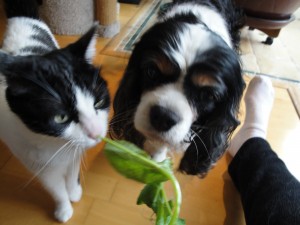 Take, for example, pea shoots. I love pea shoots. I have no idea what they are, except pea shoots, but we love them at our house, all of us, even the cat. We’re even doing a video starring pea shoots. Now, the dogs always come running when I come through the door with food, but if I say, “Pea shoots!” then Grace the Cat leaps up from her normal out cold snooze and races to hold down the kitchen counter while supervising grocery unloading.
Take, for example, pea shoots. I love pea shoots. I have no idea what they are, except pea shoots, but we love them at our house, all of us, even the cat. We’re even doing a video starring pea shoots. Now, the dogs always come running when I come through the door with food, but if I say, “Pea shoots!” then Grace the Cat leaps up from her normal out cold snooze and races to hold down the kitchen counter while supervising grocery unloading.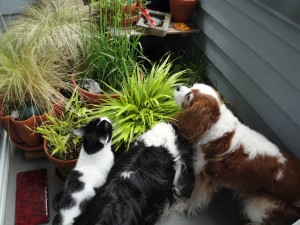 So now I’m a reformed shopper at the West Seattle Farmers’ Market. The vendors tend to explain things to me as they’re putting them in my bag: this is pea shoots, this is spinach, whatever. People in line shake their heads and sigh. But at least I get home safely. With food we kind of know how to eat.
So now I’m a reformed shopper at the West Seattle Farmers’ Market. The vendors tend to explain things to me as they’re putting them in my bag: this is pea shoots, this is spinach, whatever. People in line shake their heads and sigh. But at least I get home safely. With food we kind of know how to eat.  Here I’d been thinking I was just a bit off. And, as usual, not regretting it a bit.
Here I’d been thinking I was just a bit off. And, as usual, not regretting it a bit. And the condo? I love our condo. My multi-species family loves it. I planned for it to be a place where kids and dogs could come and go while enjoying the beach in our salty, sandy Seattle beach neighborhood. It worked really well for that. What I didn’t count on was the most obvious of all—my animals would age.
And the condo? I love our condo. My multi-species family loves it. I planned for it to be a place where kids and dogs could come and go while enjoying the beach in our salty, sandy Seattle beach neighborhood. It worked really well for that. What I didn’t count on was the most obvious of all—my animals would age. I was out with the dogs, scooping poop as we meandered down the street.
I was out with the dogs, scooping poop as we meandered down the street.